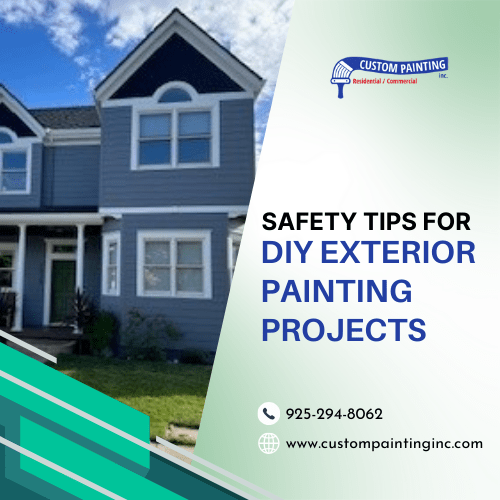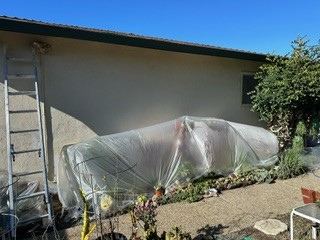Painting the exterior of your house in Pleasanton, CA, can be a big job, but it’s also very rewarding. Before you start, it’s super important to think about staying safe. This article will discuss the best ways to keep safe while painting outside. We’ll go over how to pick the right time, what kind of paint and tools you should use, and how to ensure you don’t get hurt. Whether climbing up ladders or dealing with old paint, we’ve got tips to help you. Let’s make sure your painting project goes smoothly and safely from start to finish!
Preparing for the Project
Before you dive into the task of painting the exterior of your home, it’s crucial to prepare properly. This preparation will make the job easier and ensure your safety throughout the project. Here’s how to get started on the right foot.
Choose the Right Time
Timing is very important when it comes to exterior painting. The weather can significantly affect how paint dries and how comfortable you are while working.
- Ideal Weather Conditions: Aim for a time of year when it’s dry and mild. Extreme hot or cold temperatures can affect paint application and drying.
- Avoid Rainy and Windy Days: Besides the obvious inconvenience, rain can ruin fresh paint, and wind can lead to uneven application and debris sticking to the paint.
Select the Right Paint and Equipment
Choosing the correct type of paint and having the right equipment on hand is essential for a successful and safe painting project.
- Exterior Paints: Look for paints specifically designed for exterior surfaces. These are formulated to withstand the elements and provide a lasting finish. Consider the material of your exterior (wood, brick, etc.) when selecting your paint.
- Safety Gear: Protecting yourself is key. At a minimum, wear gloves, safety goggles, and a mask to prevent inhaling fumes or dust. For higher work, a helmet can provide extra protection.
- Ladders and Scaffolding: Ensure you have stable and reliable ladders or scaffolding. Inspect them before use to ensure they are in good condition.
Proper preparation sets the foundation for a safe and effective painting project. By choosing the right time, picking suitable materials, and equipping yourself with the necessary safety gear, you’re ready to move on to the crucial steps of ensuring safety and efficiency while painting the exterior of your home.
Safety Measures
Ensuring safety during your DIY exterior painting project is paramount. This section delves into key safety measures to protect you from hazards. From ladder safety to dealing with hazardous materials, here’s what you need to know to keep safe.
Ladder Safety
Ladders are indispensable for reaching high places, but they come with risks. To minimize the chance of falls or injuries, follow these guidelines:
- Secure Placement: Always place your ladder on stable, level ground. Avoid soft or uneven surfaces that could cause the ladder to tilt or collapse.
- The Right Angle: For every four feet of the ladder’s height, the base should be one foot away from the wall. This 4-to-1 rule helps ensure stability.
- Buddy System: Whenever possible, work with a partner who can steady the ladder while climbing or working.
- Avoid Overreaching: Keep your hips within the boundaries of the ladder to maintain balance. If you can’t reach an area comfortably, climb down and move the ladder.
Dealing with Hazardous Materials
Older homes may have layers of lead-based paint, which pose health risks when disturbed. Here’s how to handle these and other hazardous materials:
- Lead Paint: If your house was built before 1978, there’s a chance it has lead-based paint. Use a test kit to check for lead, and if found, follow the EPA’s safety guidelines or hire a professional.
- Proper Disposal: Follow local laws and regulations for disposing of hazardous waste, including old paint and solvents.
Protective Gear
The right protective gear can shield you from various dangers, such as chemical exposure and physical injuries.
- Respirators or Masks: Protect your lungs from dust and fumes, especially when sanding or if lead paint is present.
- Safety Glasses or Goggles: Prevent eye injuries from flying debris, paint splatters, and chemicals.
- Gloves: Use gloves to protect your hands from harsh chemicals, cuts, and abrasions.
- Hearing Protection: If using loud equipment, like power washers or sanders, wear earplugs or earmuffs to protect your hearing.
Taking these safety measures seriously can significantly reduce the chance of accidents or health issues during your exterior painting project.
The Painting Process
Once you’ve properly prepared and taken all necessary safety precautions, it’s time to begin the actual painting process. This phase requires careful attention to technique and safety to ensure a smooth, professional finish and to avoid any accidents or injuries.
Surface Preparation
Properly preparing the surface you will paint is crucial for achieving a lasting finish. Here’s how to do it safely:
- Cleaning: Use a pressure washer or a hose with a cleaning attachment to remove dirt, mildew, and peeling paint. Wear goggles and gloves to protect against debris and chemicals.
- Sanding and Scraping: Remove loose paint with sandpaper or a scraper. A dust mask or respirator is essential here to avoid inhaling dust.
- Repairs: Fill in cracks or holes with exterior-grade filler. Allow it to dry completely before trying to sand it smooth.
- Taping and Covering: Use painter’s tape to protect windows, doors, and trim. Drop cloths or plastic sheeting can shield plants and walkways from drips and spills.
Painting Techniques
With the surface prepared, you’re ready to paint. Here are some techniques and tips to keep the process safe and effective:
- Primer: Apply a coat of primer to ensure good paint adhesion and to help achieve a uniform finish. Be sure to choose a primer suitable for your exterior surface and the type of paint you’re using.
- Using a Ladder Safely: Remember the ladder safety tips from Section 2 when painting higher areas. Keep your body centered and avoid overreaching.
- Paint Application: Start from the top and work your way down to prevent drips. Use a roller for large areas and a brush for details and edges. Be mindful of the paint’s drying times; don’t apply a second coat too soon.
- Taking Breaks: Don’t overexert yourself. Painting can be physically demanding, so take regular breaks to rest and hydrate, especially on hot days.
The painting process, from preparation to the final brush stroke, requires patience, precision, and a strong commitment to safety. By following these guidelines for surface preparation and painting techniques, you can achieve a beautiful, durable finish while keeping yourself safe.
Aftercare and Cleanup
Completing your DIY exterior painting project is significant, but the work isn’t over once the last coat of paint dries. Proper aftercare and cleanup are crucial for maintaining the safety of your environment and extending the life of your paint job. Here’s how to wrap up your project responsibly.
Cleaning Up Safely
Cleaning up involves more than just putting tools away. It’s about doing so in a way that protects you and the environment.
- Cleaning Brushes and Rollers: Clean your brushes and rollers with the appropriate solvent—water for latex paint and mineral spirits for oil-based paint. Wear gloves to protect your skin and work in a well-ventilated area to avoid inhaling fumes.
- Disposing of Paint and Solvents: Never pour paint or solvents down the drain. Check with your local waste management facility for proper disposal guidelines. Many areas offer recycling or disposal programs for household hazardous waste.
- Storing Leftover Paint: Seal cans tightly to prevent the paint from drying out. Label them with the date and the room or project for which the paint was used. Store in a cool, dry place away from direct sunlight and extreme temperatures.
Post-Painting Safety Checks
Once cleanup is complete, performing safety checks ensures that your space is safe and that your painting results last.
- Inspecting Your Work: After the paint has fully dried, inspect your work for any missed spots, drips, or uneven areas. Addressing these issues promptly will ensure a professional-looking finish.
- Checking for Fumes: Keep the area well-ventilated until all paint fumes have dissipated. If you used oil-based paint, this might take longer than with latex paint.
- Equipment Storage: Store ladders, scaffolding, and other large equipment in a secure, dry place to prevent rust and deterioration. Ensure they are out of reach of children and pets.
Conclusion
Taking on a DIY exterior painting project can be a big accomplishment. Following the safety tips and steps outlined will help ensure a smooth process from start to finish. But if you need professional help or simply want expert advice, don’t hesitate to reach out to Custom Painting, Inc. Whether you have questions or are looking for a professional touch, we’re here to help make your home look its best. Call us at 925-294-8062 or fill out our online form today. Your beautiful home is just a call or click away!




